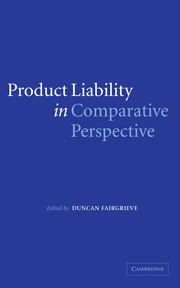Book contents
- Frontmatter
- Contents
- List of figures
- Foreword by Sir Michael Burton
- List of contributors
- Preface
- 1 Introduction
- PART I Country reports
- PART II European influences
- 9 Product liability: basic problems in a comparative law perspective
- 10 The development risks defence
- 11 Approaches to product liability in the EU and Member States
- 12 Product liability – a history of harmonisation
- PART III Comparing systems
- Appendix
- Index
9 - Product liability: basic problems in a comparative law perspective
from PART II - European influences
Published online by Cambridge University Press: 28 July 2009
- Frontmatter
- Contents
- List of figures
- Foreword by Sir Michael Burton
- List of contributors
- Preface
- 1 Introduction
- PART I Country reports
- PART II European influences
- 9 Product liability: basic problems in a comparative law perspective
- 10 The development risks defence
- 11 Approaches to product liability in the EU and Member States
- 12 Product liability – a history of harmonisation
- PART III Comparing systems
- Appendix
- Index
Summary
Product liability is the attempt to answer the question of to whom the risk of damage resulting from modern machine-guided mass production should be allocated. Should it be allocated to:
the victim, as the price for his participation in the advantages of the industrial development, but to be borne as an inevitable Act of God,
to the state, this means to all taxpayers in solidarity, or
provisionally to the producer having provided the cause of damage by manufacturing a product which did not meet the safety requirements that the public at large expects – provisionally to the producer, because he alone can distribute his expenses to the rather limited group of product users by incorporating them into his sales price?
The answer to this question seems to be one of perspective: the traditionalist prefers the first choice, a citizen believing in state-organised solidarity the second, and the person devoted to state-free liberal convictions the last one. There are no other solutions than these three. One has to decide.
Good arguments exist for each of these solutions. The Product Liability Directive, issued by the Council of Ministers in 1985, has opted for the third one. This has now been implemented by the fifteen EU-Member States, the ten applicant states, and seven other European states outside of the EU and followed by many non-European states in Asia, South America and by Australia, altogether by nearly forty states.
- Type
- Chapter
- Information
- Product Liability in Comparative Perspective , pp. 155 - 166Publisher: Cambridge University PressPrint publication year: 2005
- 4
- Cited by



